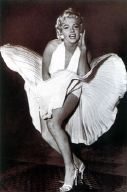 Materials
Materials
Many writers have discussed how, in the mid-nineteenth century, the Romantic
ballerina became a prototype for the “pin-up girl”, a fact made
evident by the numerous prints that circulated during these decades (and
in a comparison of an image of Fanny Elssler, a famous nineteenth-century
ballerina, with that of Marilyn Monroe). However, few have discussed how
the pointe
shoe enhanced the eroticization of the
female
form,
making
it
more “consumable” for
the middle-class male spectator. By examining the materiality of the pointe
shoe, as it existed in the nineteenth century, along with how it functioned
in relation to the ballet’s other trappings, namely the tutu and tights,
I shall explore how these elements worked together to construct the spectacle
of ideal and eroticized femininity. To aid in these investigations, I shall
also examine the lithographs and etchings from this period, which propagated
the eroticized image of the ballerina, to supplement the direct study of
nineteenth century footwear at the Bata
Shoe Museum.
This examination will
 include
a brief overview of the ballet as it operated in the preceding centuries
to give some perspective on the changes that took place during the first
half of the nineteenth
century. Critical responses to the new ballet and the reception of the critics
(and presumably, the audiences) shall also provide
useful insight into how the Romantic ballerina was perceived and constructed
during this period. For, as Jacques
Maquet (1993) points out in “Objects
as Instruments, Objects as Signs”,
include
a brief overview of the ballet as it operated in the preceding centuries
to give some perspective on the changes that took place during the first
half of the nineteenth
century. Critical responses to the new ballet and the reception of the critics
(and presumably, the audiences) shall also provide
useful insight into how the Romantic ballerina was perceived and constructed
during this period. For, as Jacques
Maquet (1993) points out in “Objects
as Instruments, Objects as Signs”,
"Meanings are not inherent
to the object (as instrumentality is) or ascribed by the designer (as the
meaning of a message ascribed to the
sender):
They
are given by the group of people to whom the object is relevant. This is
why meanings may change, and usually do, when audiences change. It is a
fallacy to think that the meaning is somehow included in the objects and
has to be
retrieved from it." (p. 35)
The pointe shoe was integral in the construction of a feminine
spectacle that was at once erotic and consumable while simultaneously a vision
of
ideal femininity.